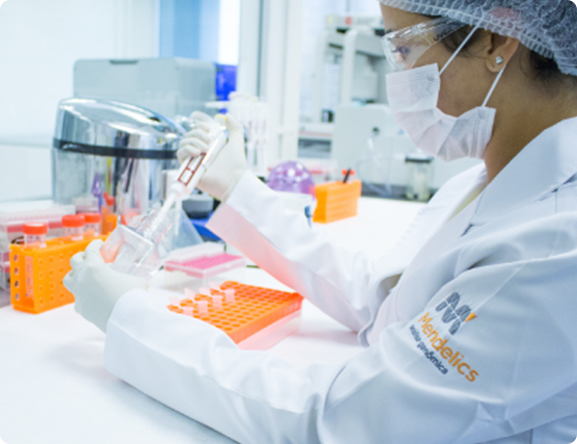NEXT GENERATION SEQUENCING (NGS)
What is DNA Sequencing?
The human genome is the total set of DNA present in each of our cells. The human genome is composed by three billion base pairs and approximately 20,000 to 22,000 genes.
The process which allows us to know the exact order of the DNA bases is called sequencing.
What is NGS used for?
The genes are the part of our genome containing the information for the production of proteins which are responsible for our body characteristics and functionalities. The genes are formed by exons and introns, but only the exons (called coding regions) are translated into proteins. The exons correspond to only 2% of the human genome.
The NGS tests intend to identify changes in the exon sequence which may affect the function of the proteins and relate them to clinical pictures.
MLPA
What is MLPA?
MLPA (Multiplex Ligation-dependent Probe Amplification) is a molecular biology technique which identifies copy number variations (CNVs) in genes that cause human disease. The CNVs includes deletions (loss of genetic material) and duplications (gain of genetic material) of more than 1 kb.
What is MLPA used for?
The MLPA can be used to identify CNVs in a single gene, in a region associated to a known syndrome and even to detect gains and losses of whole chromosomes.
Thus, the MLPA is an important diagnostic tool for patients with clinical suspicion of aneuploidies, microdeletion or microduplication syndromes, hereditary cancer and other genetic diseases caused by CNVs (Examples: Duchenne Muscular Dystrophy, Spinal Muscular Atrophy).
GENOMIC HYBRIDIZATION IN MICROARRAY
What is genomic hybridization in microarray?
The genomic hybridization in microarray is a molecular biology technique which investigates simultaneously thousands of regions in the human genome in order to identify regions of copy number variation (CNVs), which includes deletions (loss) and duplications (gains).
The CNVs detected by the microarray may include one or several genes and even affect great chromosomal segments. The minimum CNV size which can be identified is directly related to the type of microarray platform used. The microarray also detects losses and gains of whole chromosomes (aneuploidies) such as in the Down Syndrome (gain of a chromosome 21, example of trisomy) and in the Turner Syndrome (loss of one chromosome, example of monosomy).
What is microarray used for?
The microarray can be requested to diagnose patients with suspected syndromes caused by microdeletions and microduplications and is recommended to clarify several clinical conditions of unknown cause, including congenital malformations, intellectual disability, neuropsychomotor development delay, autism spectrum disorder (ASD), learning difficulties and growth restriction, among others.
There are two main types of platforms of genomic hybridization in microarrays: the CGH-array (Comparative Genomic Hybridization, CGH) and SNP-array (Single Nucleotide Polymorphisms, SNP). Both microarrays detect CNVs, however, SNP-array also identifies regions of absence of heterozygosity (AOH) in the genome.

Mendelics
Discover everything about Mendelics, our history, how we work, our publications and much more!






